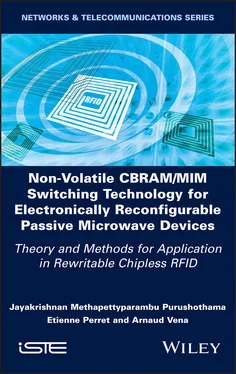1 Cover
2 Title Page Series EditorEtienne Perret
3 Copyright First published 2022 in Great Britain and the United States by ISTE Ltd and John Wiley & Sons, Inc. Apart from any fair dealing for the purposes of research or private study, or criticism or review, as permitted under the Copyright, Designs and Patents Act 1988, this publication may only be reproduced, stored or transmitted, in any form or by any means, with the prior permission in writing of the publishers, or in the case of reprographic reproduction in accordance with the terms and licenses issued by the CLA. Enquiries concerning reproduction outside these terms should be sent to the publishers at the undermentioned address: ISTE Ltd 27-37 St George’s Road London SW19 4EU UK www.iste.co.uk John Wiley & Sons, Inc. 111 River Street Hoboken, NJ 07030 USA www.wiley.com © ISTE Ltd 2022 The rights of Jayakrishnan Methapettyparambu Purushothama, Etienne Perret and Arnaud Vena to be identified as the authors of this work have been asserted by them in accordance with the Copyright, Designs and Patents Act 1988. Library of Congress Control Number: 2021949301 British Library Cataloguing-in-Publication Data A CIP record for this book is available from the British Library ISBN 978-1-78630-813-9
4 Preface
5 1 Motivation and Background: RF Switches and the Need for a Non-Volatile RF Switch
1.1. Introduction 1.2. Requirements and definition of a switch at RF and microwave frequencies
1.3. Review of RF and microwave switching technologies
1.4. State of the art of CBRAM/MIM RF switching technology
1.5. Demand for a non-volatile RF switch and selection of CBRAM/MIM technology
1.6. Conclusion
6 2 Real-World Implementation Challenges of a Low-Cost Non-Volatile RF Switch
2.1. Introduction 2.2. CBRAM-based fully passive solid-state RF switch on classic RF substrates: design and process optimization
2.3. Electrical equivalent model analysis
2.4. Effect of filament resistance of CBRAM switches on RF transmission
2.5. Time stability, switching cycles and other interesting features
2.6. Fabrication technique for realization of CBRAM/MIM RF switches on flexible substrates
2.7. Application example: design and realization of solid-state non-volatile SPDT switch
2.8. Conclusion
7 3 Solid-State Rewritable Chipless RFID Tags: Electronically Rewritable RF Barcodes
3.1. Introduction: chipless RFID technology 3.2. Chipless RFID reader system used in this experiment
3.3. Realization of solid-state electronically rewritable chipless RFID tags
3.4. Effect of CBRAM/MIM filament resistance on RCS characteristics of presented electronically rewritable resonators
3.5. Electrical equivalent model of electronically rewritable chipless RFID tags
3.6. Discussion of data encoding strategies for electronically rewritable chipless RFID tags based on CBRAM/MIM technology
3.7. Advantages of using integrated CBRAM/MIM switches for chipless RFID applications
3.8. Conclusion
8 4 Fully Passive Solid-State Electronically Reconfigurable Filter and Antenna Models
4.1. Introduction 4.2. CBRAM-MIM switches for electronically reconfigurable filter applications
4.3. MIM switches for electronically pattern reconfigurable antenna applications
4.4. Advantages of using proposed CBRAM RF switch technology for reconfigurable antenna and filter applications
4.5. Conclusion
9 Conclusion
10 Appendix
A.1. Observation of conductive filament formation in CBRAM/MIM switching cells
11 References
12 Index
13 End User License Agreement
1 Chapter 1 Figure 1.1. Ohmic contact type MEMS RF switch in series configuration
Figure 1.2. Capacitive contact type MEMS RF switch in shunt configuration on a C...
Figure 1.3. PIN diode: (a) layer architecture of a typical PIN diode; (b) electr...
Figure 1.4. Application of PIN diodes as switches in RF circuit: (a) series mode...
Figure 1.5. Simplified layer architecture of an N-channel field effect transisto...
Figure 1.6. Application of FETs as RF switches in a single pole double throw (SP...
Figure 1.7. Concept of relation among electric charge (q), magnetic flux (ϕ), vo...
Figure 1.8. Illustration of crystalline (low resistance) to amorphous (high resi...
Figure 1.9. Topology of a phase change material-based RF switch on a co-planar t...
Figure 1.10. Layer architecture of a typical CBRAM/MIM switch and its working me...
Figure 1.11. Nanoionics-based RF switch (redrawn from Nessel et al. 2008). (a) T...Figure 1.12. RF performance characteristics of nanoionics-based RF switch shown ...Figure 1.13. Nanoscale memristive RF switch (redrawn from Pi et al. 2015). (a) T...Figure 1.14. RF performance characteristic of memristive RF switch, shown in Fig...Figure 1.15. Core areas of application of a non-volatile RF switch. For a color ...
2 Chapter 2Figure 2.1. (a) The conductive bridging CBRAM/MIM switch, (b) SET, (c) RESET and...Figure 2.2. Filament formation in a copper–nafion–aluminum planar CBRAM/MIM swit...Figure 2.3. A general comparison of CBRAM technology with other well-established...Figure 2.4. Chemical structure of nafionFigure 2.5. Photograph of copper-nafion-aluminum CBRAM/MIM switch on FR-4 substr...Figure 2.6. DC pulse waveform used to operate CBRAM/MIM switchesFigure 2.7. First 130 switching cycles of one typical cell of copper-nafion-alum...Figure 2.8. The shunt mode CPW RF switch. The MIM switch is integrated by sandwi...Figure 2.9. Cross-section view of the CPW shunt mode RF switch showing the MIM s...Figure 2.10. Simulated S-parameters (full wave) of CBRAM/MIM-based 50 Ω CPW shun...Figure 2.11. Possible fragile soft spots and step discontinuity due to thickness...Figure 2.12. Photograph of the fabricated switch showing the microphotograph of ...Figure 2.13. DC voltage waveform used for operating the switch. The switch is in...Figure 2.14. DC current waveform measured along the current path of switch durin...Figure 2.15. Experimentally obtained S-parameters of CBRAM-based CPW shunt mode ...Figure 2.16. Experimentally obtained S-parameters of CBRAM-based CPW shunt mode ...Figure 2.17. Electrical equivalent model of CBRAM/MIM switch attached to a CPW l...Figure 2.18. S21 characteristics of the electrical equivalent model of the CBRAM...Figure 2.19. S11 characteristics of electrical equivalent model of the CBRAM-bas...Figure 2.20. Effect of filament resistance of CBRAM/MIM cell on RF transmission....Figure 2.21. Experimentally observed RF attenuation characteristics for differen...Figure 2.22. Time stability of set/reset states of a CBRAM/MIM switchFigure 2.23. Design of a CBRAM-based RF switch using microstrip transmission lin...Figure 2.24. Simulated S-parameters of CBRAM/MIM-based RF switch on microstrip l...Figure 2.25. CBRAM-based CPW shunt mode RF switch on paper substrate. Inset in b...Figure 2.26. Three-step process used for realization of CBRAM-based RF switches....Figure 2.27. CPW shunt mode RF switch on paper substrate with microphotograph of...Figure 2.28. Experimentally observed S-parameters of a CBRAM-based CPW shunt mod...Figure 2.29. Topology of CBRAM/MIM-based SPDT switch. Inset in green border show...Figure 2.30. Photograph of fabricated CBRAM-based electronically reconfigurable ...Figure 2.31. RF transmission characteristics of fabricated CBRAM-based non-volat...Figure 2.32. Isolation characteristics of fabricated CBRAM based non-volatile SP...
3 Chapter 3Figure 3.1. Block diagram of RF equipment setup similar to bistatic radar used f...Figure 3.2. Photograph of bistatic radar setup used for RCS measurement of chipl.
Читать дальше












